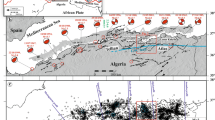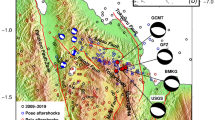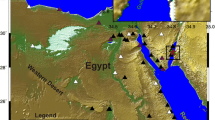Abstract
Two felt moderate-sized earthquakes with local magnitudes of 4.9 on October 11, 1999 and 4.3 on November 08, 2006 occurred southeast of Beni Suef and Cairo cities. Being well recorded by the digital Egyptian National Seismic Network (ENSN) and some regional broadband stations, they provided us with a unique opportunity to study the tectonic process and present-day stress field acting on the northern part of the Eastern Desert of Egypt. In this study, we analyze the main shocks of these earthquakes and present 15 well recorded aftershocks (0.9 ≤ ML ≤ 3.3) which have small errors on both horizontal and vertical axes. The relocation analysis using the double difference algorithm clearly reveals a NW trending fault for the 1999 earthquake. The spatial distribution of its aftershocks indicates a propagation of rupture from the SW towards the NW along a fault length ~5 km dipping nearly ~40°SW. We also determined the focal mechanisms of the two main shocks by two methods (polarities and amplitudes ratios of P, SV and SH and regional waveform inversion). Our results indicate a normal faulting mechanism with a slight shear component for the first event, while pure normal faulting for the second one. The spatial distribution of the 1999 aftershocks sequence along with the retrieved focal mechanism confirmed the NW plane as the true fault plane. While for the 2006 event, the few aftershocks do not reveal any fault geometry; its focal mechanism indicated a pure normal fault nearly trending WNW-ESE that corresponds more likely to the extension of the 1999 earthquake fault. The seismicity distribution between the two earthquake sequences reveals a noticeable gap that may be a site of a future event. The NNE-SSW extensional stress indicated by the mechanisms of these events is in agreement with the regional stress field and the rifting of the northern Red Sea in its northern branches (Gulf of Suez and Gulf of Aqaba). The source parameters (seismic moment, moment magnitude, fault radius, stress drop and displacement across the fault) were also estimated and compared based on both the regional waveform inversion and the displacement spectra and interpreted in the context of the tectonic setting. The obtained results imply a reactivation of the pre-exiting NW-SE faults as a result of extensional deformation from the northern Red Sea-Gulf of Suez rifts.
Similar content being viewed by others
Author information
Authors and Affiliations
Corresponding author
Rights and permissions
About this article
Cite this article
Elenean, K.M.A., Hussein, H.M. The October 11, 1999 and November 08, 2006 Beni Suef Earthquakes. Pure appl. geophys. 165, 1391–1410 (2008). https://doi.org/10.1007/s00024-008-0363-3
Received:
Accepted:
Published:
Issue Date:
DOI: https://doi.org/10.1007/s00024-008-0363-3




